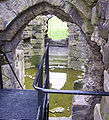Flint Castle: Difference between revisions
Created page with '{{Infobox castle |name=Flint Castle |county=Flintshire |town=Flint |picture=Flint Castle 01.JPG |picture caption=The outer bailey's gateway and donjon |built=1277-1284 |builder=…' |
No edit summary |
||
| Line 80: | Line 80: | ||
==References== | ==References== | ||
{{reflist}} | {{reflist}} | ||
Latest revision as of 12:18, 15 August 2014
| Flint Castle | |
|
Flintshire | |
|---|---|
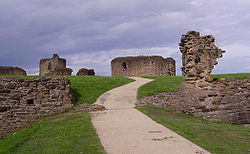 The outer bailey's gateway and donjon | |
| Location | |
| Town: | Flint |
| History | |
| Built 1277-1284 | |
| Key events: | Welsh Wars Civil War |
| Information | |
| Condition: | Ruin |
| Owned by: | Cadw |
Flint Castle stands in Flint, the county town of Flintshire. This was the first of a series of castles built during King Edward I's campaign to conquer Wales.
The site was chosen for its strategic position in the northeast of Wales. The castle was only one day's march from Chester, supplies could be brought along the River Dee and by a ford across the river crossable at low tide.[1]
Construction
Building work began in 1277 under Richard L'Engenour, who would later become Mayor of Chester in 1304.[1] The castle and its earthworks were built by 1,800 laborers and masons using local Millstone Grit ashlar and sandstone. In November 1280, the Savoyard master mason James of Saint George began overseeing construction at Flint for Edward I.[2] He remained at the castle for 17 months.[1] James of Saint George then moved onto Rhuddlan to oversee its completion.
When work ceased in 1286, Flint Castle had an inner ward and an outer bailey. They were separated by a tidal moat and were connected with gatehouse and drawbridge. A plantation town was also laid out beyond the outer bailey. The inner ward had three large towers and a detached keep. This isolated tower protected the inner gatehouse and outer bailey. In total expenditure, Edward I spent £6068.7.5d. creating the fortress and the town.
Flint, which was sited on the western shore of the River Dee estuary, could be supplied by river or sea. Its harbour was protected by a defensive wall. The castle lies opposite the Cheshire shore and Shotwick Castle. Before the river's course was drastically changed in the 18th century, passage across the estuary at this point could be made directly by boat at high tide or by fording at low tide.
Unique fortress design
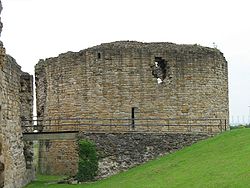
The castle is based on mediæval French or Savoyard models where one of the corner towers is enlarged and isolated.[3] This independent structure served as both corner tower and keep or donjon, as at Dourdan in France. Flint's keep has been compared to the donjon at Aigues-Mortes, France. Edward I would have been familiar with Aigues-Mortes having passed through the fortress on the way to join the Eighth Crusade in 1270.[4]
The keep is an impressive structure. Its stone walls are 23 feet thick at the base and 16 feet above. Access was gained by crossing a drawbridge into a central entrance chamber on the first floor. Originally there would have been at least one additional storey. These floors had small rooms built into the thick walls. A timber gallery was built on top of the keep for the visit of Edward, Prince of Wales in 1301. On the ground floor is a vaulted passage that runs all the way around the inside of the keep.
Flint's design was not repeated in any other castle built by Edward I in North Wales. The layout at Flint remains unique within the British Isles.
History
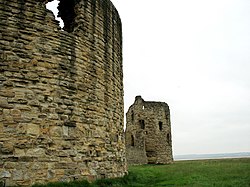
Flint was the first castle of what would later become known as Edward I's "Iron Ring". A chain of fortresses designed to encircle North Wales and prevent uprisings. Its construction began almost immediately after Edward I began the First Welsh War in 1277.
Five years later, Llywelyn the Last was dead and rebel forces under the command of his brother Dafydd ap Gruffydd besieged the castle, only to be put down: Dafydd was slain barely a year after his brother. In 1294 Flint was attacked again during the revolt of Madog ap Llywelyn; this time the constable of the castle was forced to set fire to the fortress to prevent its capture by the enemy. The castle was later repaired and partly rebuilt.
With the conclusion to the Welsh Wars, English settlers and merchants were given property titles in the new town that was laid out in front of the castle. The plantation borough was protected by a defensive ditch with a wooden palisade on earth banking. Its outline remains visible in streets patterns.
In 1399 Richard II of England was held by Henry Bolingbroke at Flint before being returned to London.
During the Civil War, Flint Castle was held by the Royalists. It was finally captured by the Parliamentarians in 1647 after a three-month siege. To prevent its reuse in the conflict, the castle was then slighted by order of Parliament to put it out of military use. The ruins are what remain today.
By the 19th century part of the site's outer bailey was used as Flintshire's County Gaol. A quarry also operated nearby.
Present day
Flint Castle, which has been managed as public monument for 90 years, is now maintained by Cadw. Access is free and by way of a path. Most parts of the castle, such as the isolated keep, are open to the public.
Miscellany
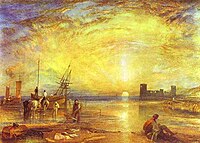
In 1838 J M W Turner painted a watercolour of the castle.
HMS Flint Castle (K383) was a Royal Navy Castle Class corvette launched in 1943, named after Flint Castle.
Pictures
|
Outside links
| ("Wikimedia Commons" has material about Flint Castle) |
- www.castlewales.com : Further details + photos
- Pictures of Flint Castle and the area on Geograph.co.uk
References
- ↑ 1.0 1.1 1.2 "Flint Castle". Fflint. 2009-10-18. http://www.fflint.co.uk/castle.html.
- ↑ Walker, David (1990). Mediæval Wales. Cambridge University Press. pp. 134–5. ISBN 978-0-521-31153-3. http://books.google.co.uk/books?id=2GAaZNDmOZEC. Retrieved 2009-04-18.
- ↑ Taylor, Arnold J (1986). The Welsh Castles of Edward I. London: Hambledon. ISBN NA497 G7T39 1986.
- ↑ Sancha, Sheila (1991). The Castle Story. London: Collins. p. 224. ISBN 0-00-196336-8.





